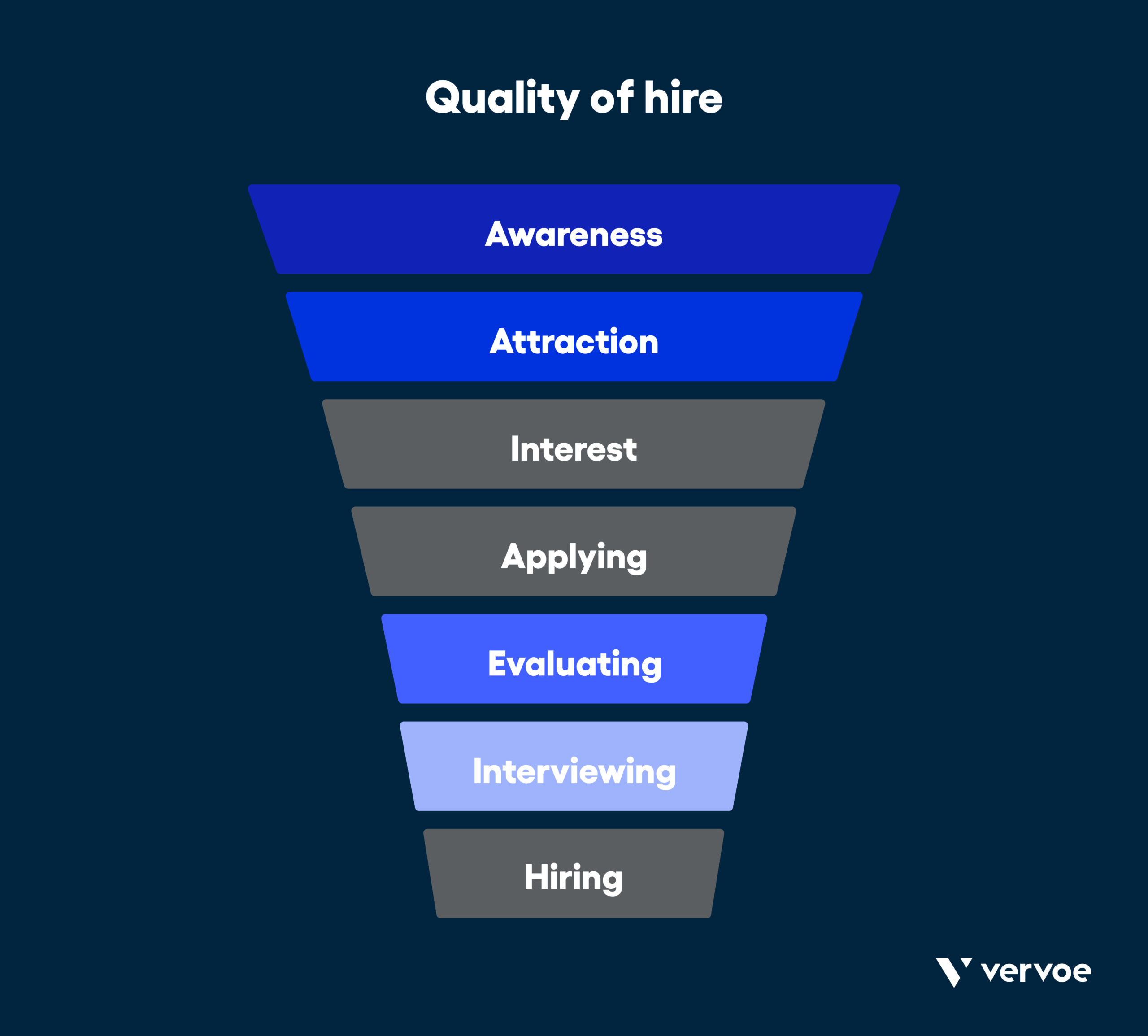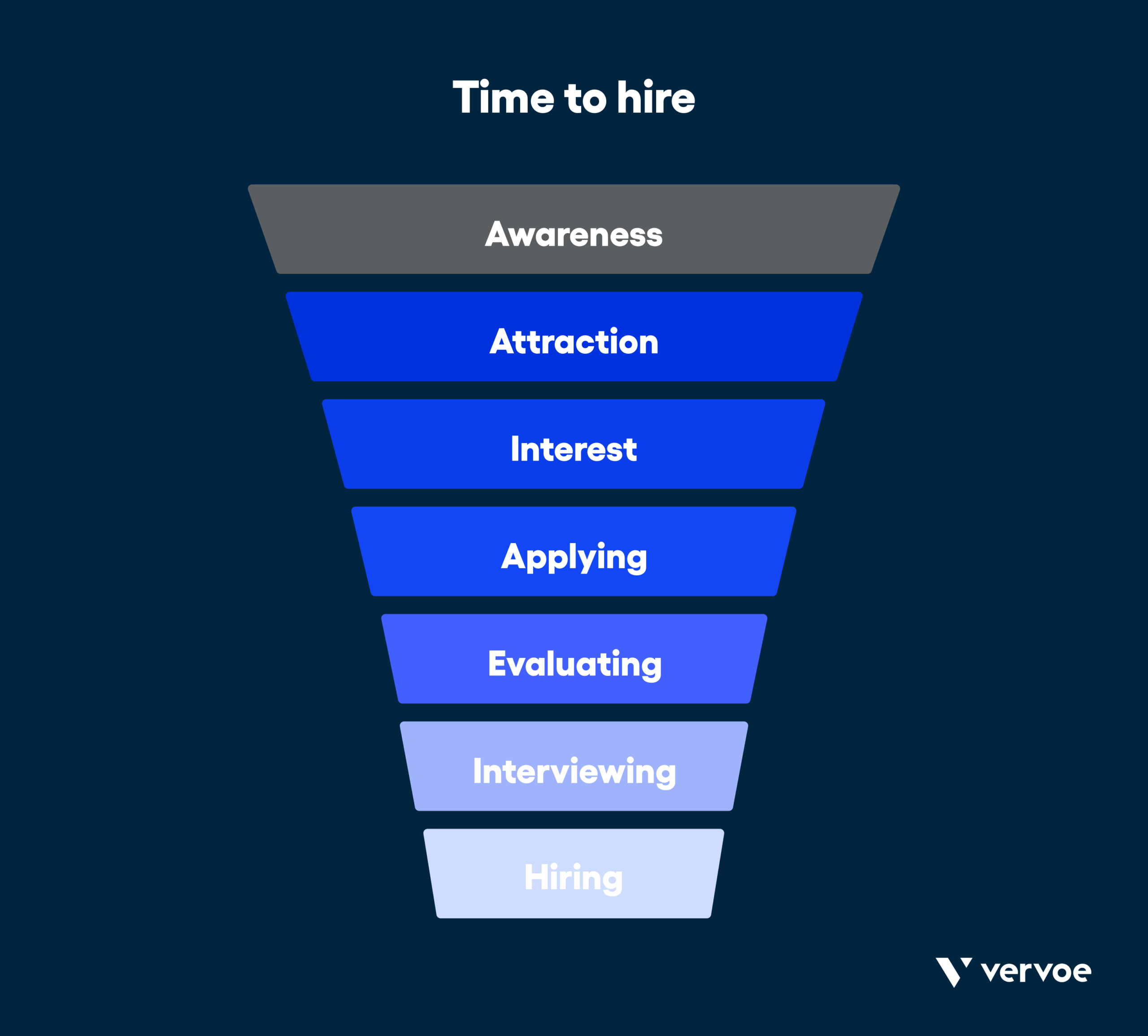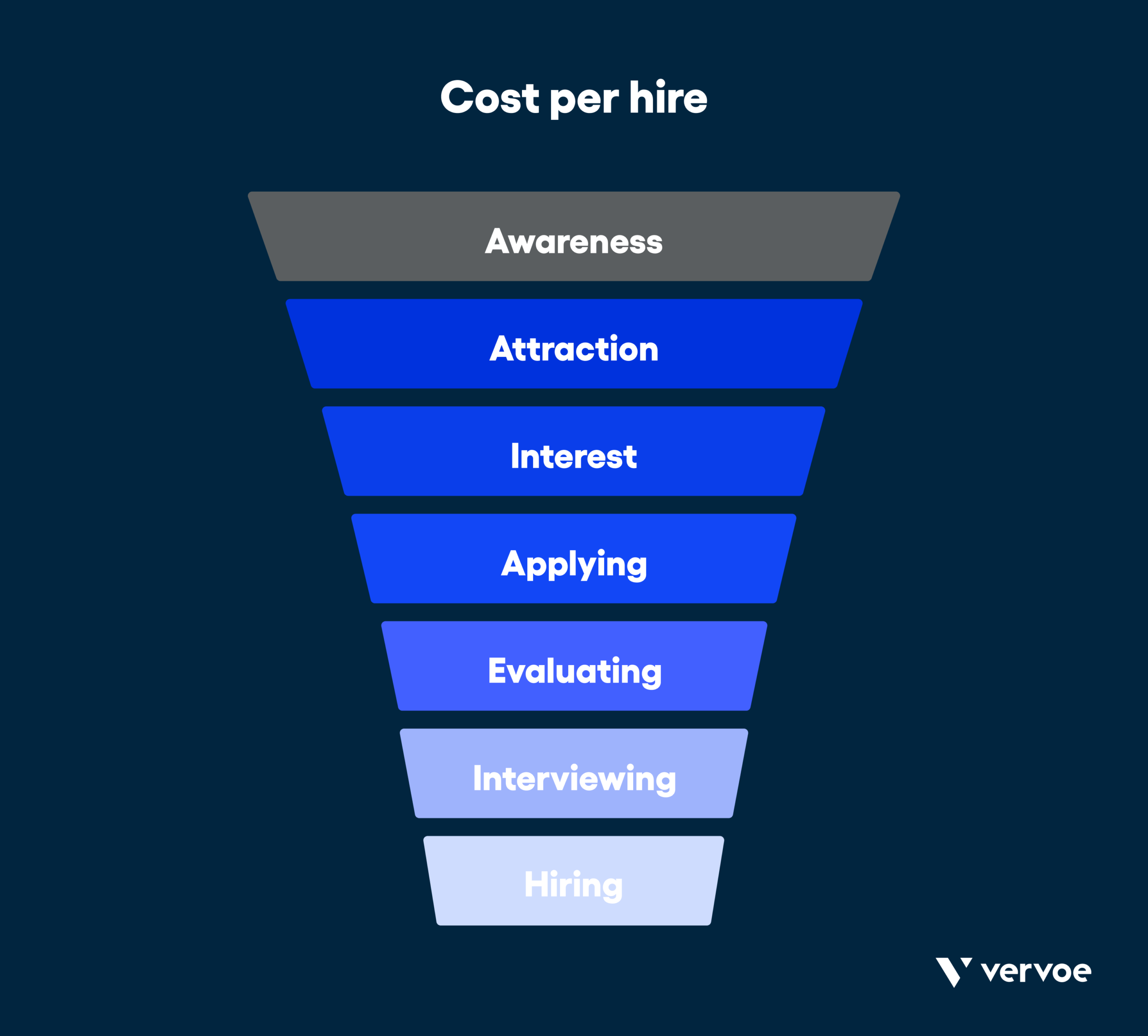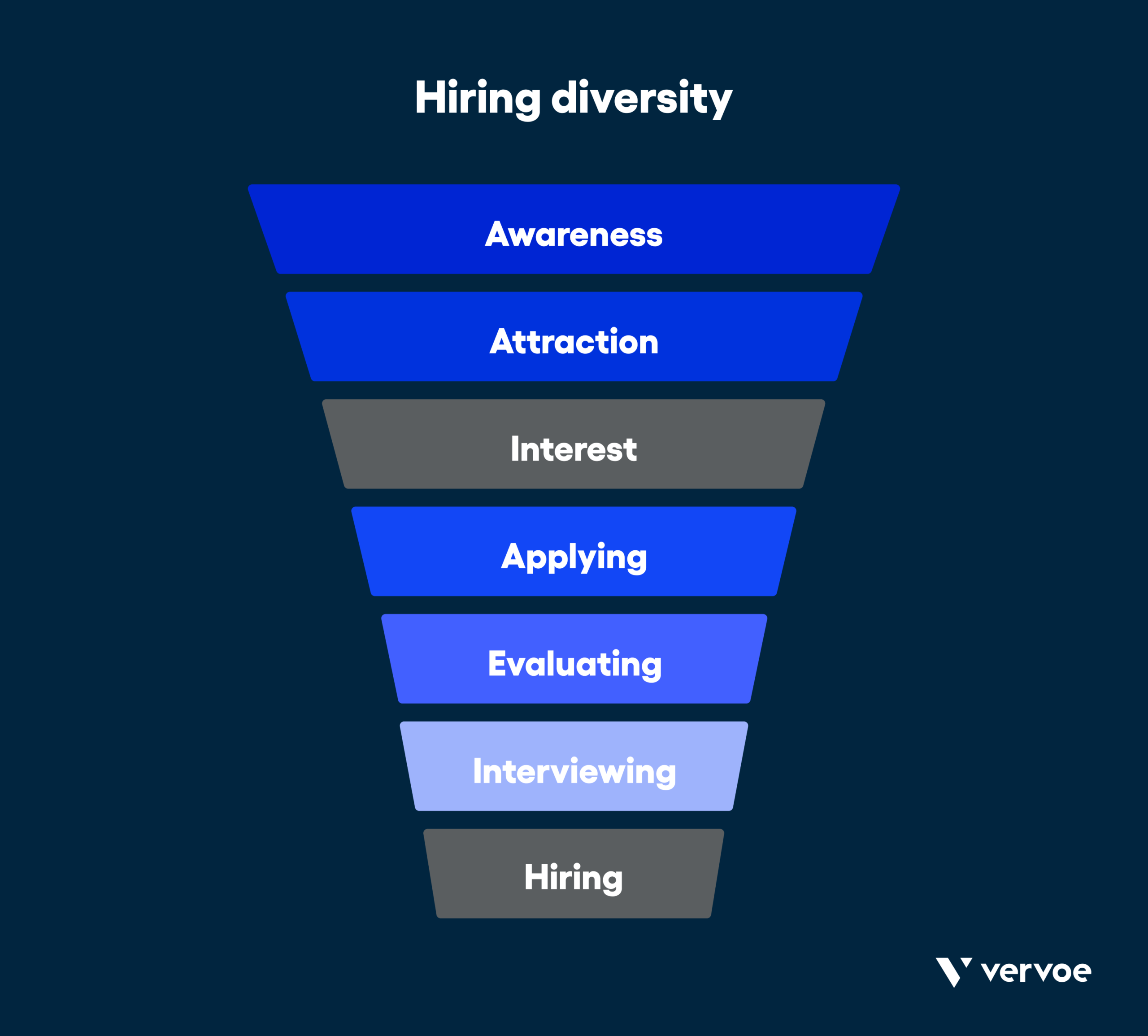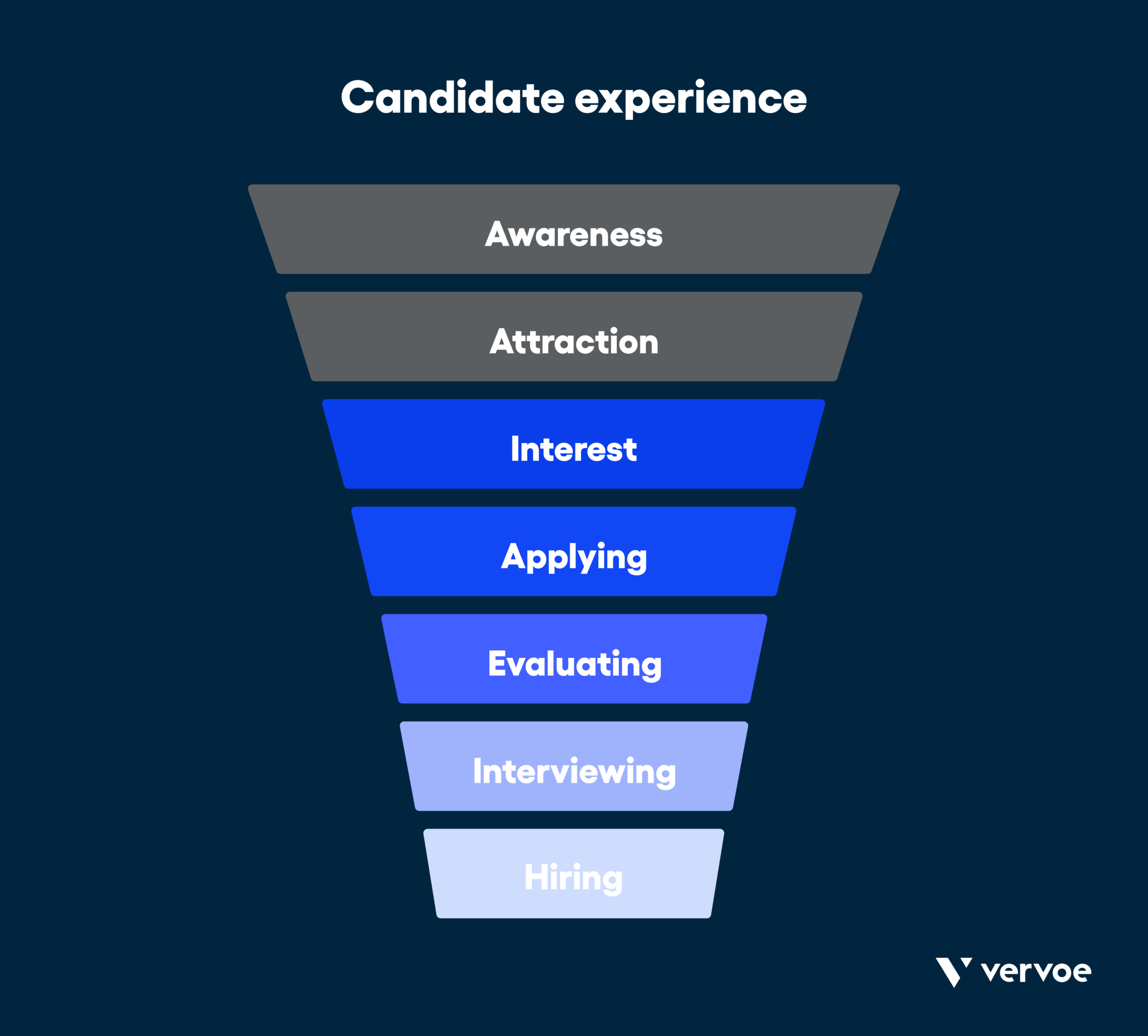So, you’ve created a recruitment funnel: a useful tool to help you visualize every step of the talent acquisition process, and think holistically about hiring.
But, is it effective? Can it be measured and improved? If so, which stages of your recruitment funnel need attention?
As the recruitment process becomes more and more automated, the job of a human talent professional will increasingly focus on tracking recruitment metrics and improving them by tweaking various stages of the funnel.
This article explores six crucial recruitment metrics and shows you how they can be improved with targeted changes to different parts of the hiring funnel.
Before we begin, let’s take another look at Vervoe’s funnel metrics in recruitment to remind you of the seven key stages.
1. Quality of hire
Why measure quality of hire?
You’re not hiring merely to fill seats. Your organization’s goal – to state the obvious – is to hire the highest-quality people to drive business performance forward.
Tracking top recruitment funnel metrics like this will help you determine if you are consistently hiring top performers, or if your recruitment process is only delivering low and average-quality hires.
Armed with this information, the next step is to make targeted improvements to your recruitment funnel.
How to measure quality of hire
What determines the quality of an employee? It depends on what they do for a living. Perhaps they consistently smash their sales targets, or maybe they create excellent code. High-quality hires help to reduce turnover, enhance workplace culture, and can supercharge financial performance for your business.
Quality of hire shouldn’t be a subjective measurement. Define the factors that drive top performance for a particular role, then measure quality through performance reviews, hiring manager satisfaction surveys, and retention tracking. You may also choose to measure the time it takes for a new hire to reach full productivity.
How to improve quality of hire
The key stages in your recruitment funnel for improving your quality of hire are Awareness, Attraction, Assessment, and Interviewing.
Awareness: A bigger talent pool means more high-quality candidates entering the funnel. Boost your awareness efforts by building your employer brand.
Attraction: Are you attracting the right quality of candidate? Improve this by optimizing your job ads, ensuring you post ads where your target audiences are, making sure salaries are competitive, and working to highlight the benefits that make your company stand out, like excellent flexibility or strong values.
Evaluating: The key to improving quality of hire is to see people do the job, before they get the job. Use a skills assessment to hire based on proven test results, not on the strength of a résumé or interview.
Interviewing: Use the interview to explore areas that were not covered by the test, or dig deeper into skills where the candidate scored poorly.
2. Time to hire
Why measure time to hire?
Typically, longer time to hire will mean an increased cost per hire. Organizations also suffer from indirect costs stemming from a role remaining unfilled.
How to measure time to hire
It would be great to measure time to hire from the moment a prospective candidate first enters your recruitment funnel, but realistically, you can only measure this from the time they first make contact; usually at the application stage.
Therefore, time to hire is measured by counting the days between the application and the moment the successful candidate accepts the job.
Are there time-to-hire averages and benchmarks available? A quick Google will there are. But a word of warning: your time to hire averages should vary according to the unique requirements of every position. While common positions can be filled in under 30 days, high-demand roles such as data engineers can take over five months.
Knowing your average time-to-hire for different roles is extremely valuable in terms of helping you accurately gauge how long it will take to fill a vacant role in the future.
How to reduce time to hire
Time-to-hire can be reduced by looking for efficiencies, streamlining, and, if possible, automating every stage of your metrics recruiting funnel from the Attraction stage onwards.
Attraction: Consider the time savings of an automated job ad placement.
Interest: If answering questions from potential candidates is slowing down the recruitment process, make as much information available as possible via a FAQ page, instructional videos, or consider investing in a chatbot.
Applying: Streamlining a lengthy application process is a key way to reduce time to hire, and improve the candidate experience. Ensure subsequent communication, such as acknowledging receipt of the application, is automated.
Evaluating: Skills testing provides massive benefits in terms of quality of hire, but will dramatically increase your time to hire if tests are evaluated manually. Look for a fully automated skills testing solution.
Interviewing: Shave time from this stage of the hiring funnel off with meeting scheduling software and structured interviews. Using a skills test will reduce or eliminate the need to quiz candidates about their skill sets at this stage. Interviews can be automated with the candidate answering pre-recorded questions by phone or video, but keep in mind the responses will need to be reviewed by a human at some stage.
Hiring: While it’s possible to automate the job offer letter, it is preferable to retain the human touch by phoning the successful candidate or sending a personalized communication. Save time at the hiring stage by going paperless (look into digital signatures), and create a seamless, automated onboarding process.
3. Cost per hire
Why measure cost per hire?
Measuring cost per hire provides you with a benchmark for driving recruitment costs down, alerts you to rising recruitment costs, and helps inform future recruitment budgets.
How to measure cost per hire
Cost per hire is calculated by dividing the internal and external recruitment costs by the total number of hires in a set period. Benchmarks range from $4000 per hire to $18,000+ for executive positions.
Internal costs include your talent acquisition team’s salaries, any employee referral bonuses, and the hourly salary of the people conducting interviews. External costs include job advertising, recruitment agency fees, recruitment software subscription costs, and costs such as reimbursing candidate travel expenses.
How to reduce cost per hire
Cost per hire can be reduced by looking for cost savings in nearly every stage of your recruitment funnel.
Attraction: Review the cost of your job ad placements. Are you posting in too many places? Are some more expensive than others? And, if so, are they providing ROI as an effective source of hire?
Interest: It’s important that you’re prepared to answer questions from potential candidates, but this can get expensive in high volume hiring. Consider automation or outsourcing your call center to a low-cost country.
Applying: Automate the application process. This means the candidate’s data should automatically be captured in your ATS, the candidate should receive an acknowledgment of receipt, and the next stage should be launched automatically.
Evaluating: Manual evaluation, like résumé reviewing or skills testing, is extremely time-consuming, inefficient, and expensive. Reduce costs by using a fully automated solution for this stage.
Interviewing: Keep interviews to a set length – usually between 45 minutes and one hour – to minimize the costs of having your panel members present. Conducting virtual interviews can reduce office space costs.
Hiring: Costs can be reduced by shifting to a remote hiring model, cutting the need for relocation costs, office space, and services such as office cleaning.
4. Source of hire
Why track source of hire?
Keeping track of where new employees are coming from can be useful for refining your talent attraction efforts. It can show, for example, if your newly launched careers page is generating any clicks, or whether candidates are coming from job boards, social media, referral programs, or external recruitment agencies.
Organizations can use this recruitment funnel analysis data to inform decisions such as ramping up social media, investing in a premium ad on a job board, or switching recruitment agencies.
Source of hire versus source of candidate
Tracking source of hire is much more effective than tracking source of candidate. After all, you want to know where the best performers are coming from, not the candidates who don’t make the grade. You may prefer to track the source of all candidates who reach the interview stage, or the source of all candidates that score highly in your skills test.
Many talent professionals prefer to track “sourcing channel effectiveness”; a term that is closely linked to the quality of hire metric (see above). In other words, they want to know where the best hires in the business have come from so they can put more resources into these sources.
How to track source of hire
Source of hire can be tracked via:
- Tracked links: A common technique in digital marketing, using tracked links allows you to analyze where a candidate clicked through to your job application.
- Candidate surveys: Ask the candidate where they saw your job posting. This can be asked either within the application questionnaire or via a survey at the end of the recruitment funnel.
How to improve sourcing channel effectiveness
Funnel analysis in recruitment is about sourcing channel effectiveness and getting more bang for your buck. It takes the guesswork out of which recruiting marketing channel to use.
Awareness and Attraction: Use this metric to redistribute your marketing efforts in the awareness and attraction stages. You may choose to withdraw from some channels, double down on others, or explore new methods of attracting job seekers, such as encouraging employee advocacy.
Remember that you can improve channel effectiveness by tailoring your message to different audiences. Don’t use a one-size-fits-all approach.
5. Hiring diversity
Why measure hiring diversity?
There’s no question that talent diversity boosts business performance. But your recruitment funnel may be set up in a way that discourages diverse candidates from applying. Measuring hiring diversity will help you spot issues such as biased interviewing against numbers of applicants, or non-inclusive job advertisements, and take action.
How to measure hiring diversity
Measure hiring diversity with demographics surveys to track the conversion rate of employees from specific identity groups (e.g. LGBTQIA) entering your funnel and being hired. Results can then be measured against internal diversity targets and industry benchmarks.
This data can then be correlated with other recruitment funnel metrics to gain specific insights about various stages. For example, you may discover that your job description scored poorly among female candidates, or your assessment stage caused high attrition for candidates with disabilities.
How to improve hiring diversity
Improving hiring diversity will bring better talent into your organization, boost business performance, and improve your company’s reputation as a diverse and inclusive employer. Examine every stage of your recruitment funnel through the diversity lens.
Awareness: Are your outreach efforts reaching candidates in diverse groups? For example, you may want to attend veteran’s job fairs to increase awareness of your employee brand among that specific group. Ensure diverse groups are represented in any recruitment videos and your careers site.
Attraction: Review your job descriptions and weed out non-inclusive or gendered language. Use tools like The Gender Decoder to remove biased words from your job ads. If your organization does not have one, publish a Diversity and Inclusion Statement on your website.
Applying: Ensure your application process is built around best-practice accessibility guidelines. Eliminate bias at this stage through blind hiring, which removes identifiers like the candidate’s name, headshot, education, and location.
Evaluating: Be aware that résumé evaluation is a minefield for inherent bias. Instead, use merit-based skills testing that will score and rank candidates only on their ability to do the job.
Interviewing: Offer remote interviewing for candidates with mobility restrictions. Have a diverse interview panel, avoid one-to-one interviews, and ensure all interviewers have been trained in D&I, and avoiding bias.
[Read more: The Ultimate Guide to Diversity Hiring]
6. Candidate experience
Why measure candidate experience?
A positive candidate experience is crucial for an effective recruitment funnel. A poor experience could cause a star candidate to drop out of the process along the way, especially at key points such as the job application, evaluation, or interviewing. Poor candidate experiences have also been linked to retention issues and whether offers are accepted.
An IBM study found that unsuccessful applications are 80% more likely to apply again if they enjoyed a positive experience and linked candidate experience to higher job acceptance rates and increased employee advocacy.
Remember, too, that candidates are customers and may walk away from your product or service if you’ve subjected them to a poor hiring experience.
How to measure candidate experience
Use an automated survey tool to capture candidate experience. Not everyone will answer, but any information you capture will be essential for improving your recruitment funnel effectiveness.
You may choose to send candidates:
- A survey at the end of the process, such as after the successful candidate has accepted the job offer.
- A survey at the point candidates exit the funnel (when you inform candidates they were unsuccessful).
- Several micro-surveys at key points throughout the process.
Micro surveys are effective because they’re quick and easy – often consisting of only one or two questions – and they capture information immediately after an event such as the job application. Surveying candidates while they are still in the running for the role will mean they are more motivated to reply.
How to improve candidate experience
Think holistically and consistently about your recruitment funnel candidate experience. There’s little point in treating candidates like VIPs during the interview stage if they have had a substandard experience when filling out the application form.
The best advice for improving candidate experience is to communicate. Never ghost candidates, keep them informed of the next steps, and let them know if there are any delays. Candidate communication can be automated, but make sure your messaging sounds human, not robotic.
Interest: Candidates will expect a fast and helpful response if they reach out with questions about the role. Failing to answer questions could lead to candidates developing a negative impression of your organization very early in the funnel.
Applying: The job application stage is a key point that determines candidate experience. Ensure it is user-friendly, not too long, not too complex, optimized for mobile, and doesn’t have annoying requirements such as specific file types. Keep track of how many candidates fail to complete the application.
Evaluating: Ensure skills tests are not too long or too complex. Use a mix of Q&A formats and ease into the assessment by building the level of difficulty. Use assessment insights to discover where candidates are dropping out.
Interviewing: 65% of candidates say a bad interview experience led them to lose interest in a job. Improve the in-person interview experience by treating them like a VIP: give them an office tour, and introduce them to senior managers if appropriate. Don’t cancel or reschedule an interview at the last minute, and don’t require more than two interview stages (one is better). The same applies to remote interviews, with the added challenge of potential technical trouble. Check out Vervoe’s guide to remote interviewing here.
Hiring: Roll out the red carpet when making the job offer. If the successful candidate is the best of hundreds of applicants, it’s likely they are considering offers from other companies. Tailor the job offer to include the benefits that are important to them, and don’t send a boring automated email. Invest in a best-practice onboarding tool that keeps the candidate fully engaged and enthusiastic from the moment they accept the job.
Finally, put some thought into the way you inform a candidate that they are unsuccessful. This can be a crushing experience for many hopeful candidates, so be empathetic and encouraging.
In this video from BHP, a talent professional empathizes with disappointed candidates and encourages them to try again:
Conclusion
If you don’t measure something, you can’t improve it. Keeping track of the six recruitment funnel metrics explored in this article will help you optimize every stage of the hiring process.
Which recruitment funnel metrics are the most important to track? It depends on your organization’s current priorities. Perhaps the business is focused on improving diversity, or maybe they want to reduce the costs of recruitment. The key is to know what changes to make to move these metrics in the right direction.




